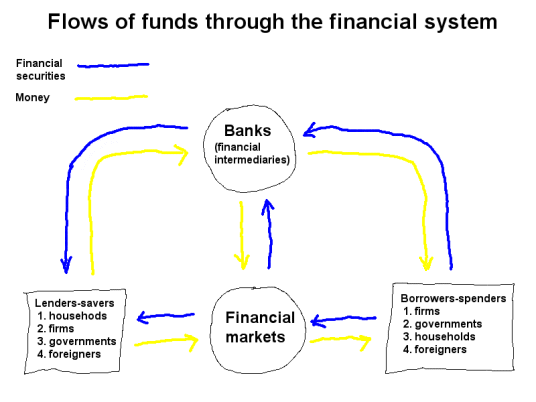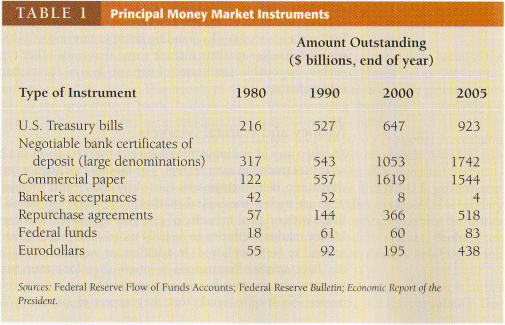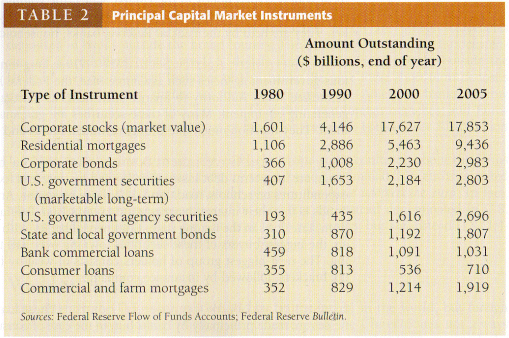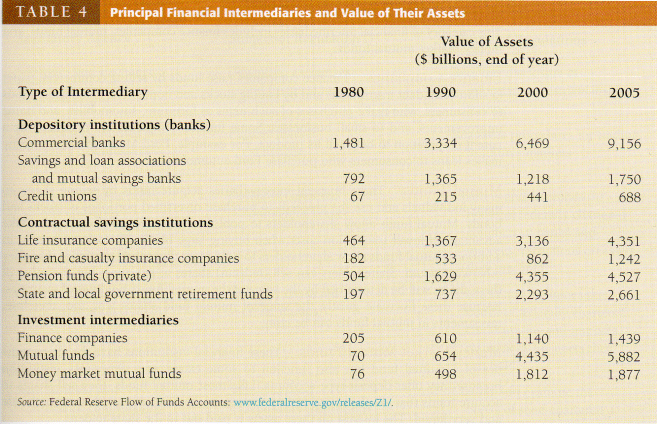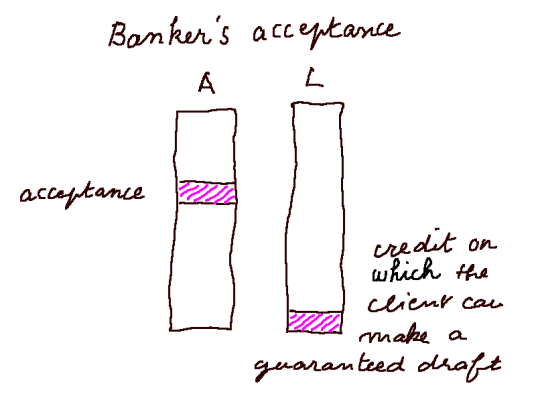Advanced financeLesson 3: Money markets
In every country, the general flows of funds through the financial system can be represented like this:
(adapted from Mishkin, The Economics of Money, Banking and Financial Markets, Addison Wesley, 8th ed., 2007, p. 24) (Note: sometimes the counterpart to a (blue) security flow can also be a security flow rather than (yellow) money.) The above flows represent only financial investments. They are funneled directly by financial markets, and indirectly by banks and other financial intermediaries, from lenders to borrowers. Terminology
Conversely, the borrowers are also called:
The other big flows
Flows of liabilities Liabilities are financial securities and have value The role of money, financial products, and financial markets is to distribute these liabilities (by definition, involving time) among economic agents, to make the economic system function.
Money markets (from Levinson, chapter 3) Maturity less than one year Issuers have short term needs, often seasonal Big development since 1980
Source: Levinson p. 42
Difference between the money market and the bond market: Long term projects Risk Money markets help bond markets. Price of liquidity
US money markets
US capital markets
US intermediaries
Source: Mishkin
The investors/lenders in the money market: Short-term instruments are often unattractive to investors because of the high cost of learning about the financial status of a borrower. For this reason, investors typically purchase money-market instruments through funds. Money-market funds Investors in US money market funds had $1800 billion in assets, in these funds, in 2005. This represented appromitaly 20% of the world money market assets. Individual sweep accounts Institutional investors Investment trusts (= mutual funds), which hold a portfolio of bonds and equities, keep a part of their assets in money market instrument. The idea is to be able to meet the demands of investors to redeem their shares without having to liquidate long term assets.
Types of instruments, and their issuers/borrowers Commercial paper Its maturity is usually between 90 days and 270 days. Commercial paper is usually unsecured. Dates from the XIXth century Less costly, for the borrowers, than banks Decline when the short rates were very low. Investors
less interested Financial firms in the US have become the main issuers of commercial paper:
Roll over Beneficial for issuer, but dangerous
Bankers' acceptances Before the 1980's, bankers' acceptances were the main way for firms to raise short-term funds in the money markets. An acceptance is a promissory note issued by a non-financial firm to a bank in return for a loan. Acceptances usually have a maturity of less than six months. Bankers' acceptances differ from commercial paper in significant ways. They are usually tied to a specific commercial transaction. Examples:
Bankers' acceptances do not bear interest (for the buyer, on the secondary market); instead, an investor purchases the acceptance at a discount from face value, and then gets back its face (from the initial issuer) at maturity. Investors rely on the strength of the guarantor bank, rather than of the issuing company, for their security. When banks were able to borrow money at a lower cost than other types of firms, bankers' acceptances allowed manufacturers to take advantage of bank's superior credit standing. This advantage has largely disappeared, as many other big corporate borrowers are considered at least as creditworthy as banks. They no longer play a significant role in the US. They amounted to $4 billion in 2005, one tenth of their value outstanding in 1980.
Treasury bills They are securities with a maturity of one year or less, issued by national governments. The mix of money-market and longer-term debt issuance varies considerably from government to government and time to time. The US government sought to reduce the average length of its borrowing, starting in 1996, to reduce interest costs, but then announced in 2005 that it would resume issuance of 30-year bonds to finance an increased national debt. National particularities In cases where a government is unable to convince investors to buy its longer-term obligations, treasury bills may be its principal source of financing. Emerging-market countries Thanks to rise in oil and commodity prices, Brazil is now, as of 2008, a country with sound finances.
Government agency notes and local government notes
Interbank loans Banks constantly lend money, on a very short term
basis, to one another Tightening up of this market Three articles on ECB cash injection (Telegraph, December 2007):
Leading interest rates
US federal funds rate
Time deposits Also called Certificates of deposit, or CDs. They are interest bearing deposits, but cannot be withdrawn before maturity without a penalty. Although they can last as long as 5 years, most of them qualify as money market instruments because they have less than one year maturity. Large time deposits are often used by corporations, governments and money-market funds to invest cash for brief periods.
International agency paper The World Bank, the Inter-American Development Bank and other organizations owned by member governments issue this type of paper, denominated in many different currencies.
Repos Combination of two transactions
This is equivalent to lending/borrowing, guaranteed with financial securities (in French, "prêt sur gage" où le gage est un actif financier) Specifities of repos
Repos serve to keep the markets highly liquid, which in turn ensures that there will be a constant supply of buyers for new money-market instruments. Any type of security can be used, although in practice the overwhelming majority of repos involve national governments notes. In a reverse repo, the roles of the investor and of the dealer are switched.
Nowadays, repos, rather than open market operations, are used by governments to control the money supply (in other words, the amount of liquidities in the system). The average maturity of a repo is only a few days.
Historically, until 1993, repos have been discouraged in France, where the legal basis for them was unclear. But since 1993, the market for repos became quite large. (French repos.) In Germany, banks were forced to set aside reserves for repo transactions until 1997, making such transactions uneconomic.
Watching short-term interest rates Central banks, governments and investors pay close attention to short-term interest rates. Spreads Spreads (= the differences in interest rates on different instruments) are highly sensitive indicators of market participants' expectations. Uncollateralized loans and repos Comparing spreads in various countries is instructive. During the winter 1998, for example, the average spread between uncollateralized three-month loans and three-month repos were
The general view was that many Japanese banks were extremely weak. The spreads between different categories of commercial paper are also closely watched. The spread between AA paper and weaker A2-P2 rating is usually 15 to 20 points. A widening may indicate that investors are worried about a deteriorating economy, which would be more likely to cause financial distress for issuers of A2-P2 paper than for issuers of stronger AA-rated paper. Signs of markets anxiety
Le Monde, 6 March 2008 by Sylvain Cypel
"It is Main Street against Wall Street", people against moneymakers which choke it. With an innate sense of the formula, Barack Obama used this sentence during the debate which opposed him to Hillary Clinton in Cleveland, the largest city of Ohio [the state capital being Columbus], where a primary election was held Tuesday March 4, to designate the state democratic delegates for the nomination of the national party candidate in the November elections. A punchy sentence which here the senator of Illinois knew would resonate instantly. Without the brilliant rhetoric, Hillary Clinton did in fact play the same score. "To understand which factors drove people's votes here, said Edward Hill, rector of the College of Urban Affairs at the state university of Ohio, one must consider the rising insecurity which reaches our middle class, and on top of which now weighs the subprime mortgage crisis." This insecurity comes from a long time ago, from the 1970's and 1980's. Like the Lorraine region of France, Ohio was the "steel heart" of the United States: the steel industry dominated it. And here too it sank. The biggest players - US Steel, Memphis Steel, Republic Steel - delocalized or changed activities. The deterioration of employment was aggravated in the 1990's by the crisis of the automotive sector. Ohio was the main subcontractor to Michigan, "the car state" just across the state border. Out of fifty subcontractors to the auto industry twenty years ago, only eleven remain today. On February 27, Honda announced it was closing its motorbike plant in Marysville. The Japanese manufacturer had already moved its off-road vehicles division to North Carolina in 1997. In 2007, 93 small businesses closed their doors. From beacon of the "American dream", Cleveland (900 000 inhabitants in 1950, 430 000 today) has become its nightmare. The city is at the same time younger and older than the national average: a gaping hole is in the middle range, in the 25-50 years old. "The American dream: it is a stable job, together with good social protection, which allows the children to receive good schooling, and, most important, which gives access to home ownership", says Robert Triozzi, director of the city hall legal department. In the state, however, 160 000 "stable" industrial jobs were lost since 2001, which represent 17% of the total. The number of people receiving unemployment financial help grew by 20%. With the deindustrialization, the dream went to rags. With the subprime mortgage crisis it collapsed altogether. "More and more people are hurt in their flesh by the bad sides of our system, the extreme deregulation of the economy", summarizes Frank Jackson, the Democratic city mayor. Named "poorest city of the United States" in 2004, Cleveland ranks fourth for the number of insolvent borrowers. From 182 in 2003, the number of home seizures jumped to 1926 in 2005, and then to 7800 in 2007. The city hall forecasts 13 000 this year. Courts order 200 to 300 new seizures a week. Approximately 12% of the flats are currently vacant, their ex-owners having found refuge, suitcase in hand, at some relatives, or having left the Cleveland area. Entire city districts are falling apart. "Men lose their jobs. Then the whole family loses its medical coverage, it can longer pay for the kids studies, and if we are indebted that's it. And here, everybody is indebted." This simple summary is given by Anita Williams, a 52 year old black housewife from Mount Pleasant. Blacks, in Cleveland, make up 3/4 of the insolvent borrowers. Like Slavic Village or East Cleveland, where 40% of the tenements are under threat of seizure, the sector of Mount Pleasant is mostly inhabited by black people. Around Kinsman Avenue, in some streets, a fourth of the small wooden houses, typical of industrial cities were seized. Sealed front doors, windows boarded with planks. Conmen abound On numerous front sides, a large post says: "No copper, all PVC plumbing". A message to robbers. Bands of them scout these districts in search of seized flats, to tear off whatever can be taken. The petty criminals look first of all for metals which they resell to scrap metal dealers. They operate at night, "and sometimes even in daylight. Before we have the time to arrive, they are gone", say the police. "Not true, reply the residents, the police no longer bother to come." The truth is in between: the police are overworked. "If nothing is done, 2009 is going to be worse", forecasts Mr. Hill The city provides two services to families, one legal and one financial, so that they don't fall victims of a "second rip-off". Because conmen abound. Some of them are well known and advertise their activity. With ads on tv they vaunt their fabulous offers. To insolvent borrowers they propose to refinance their mortgage or to simply buy their house, under conditions they don't specify because they are outrageous. To potential buyers, these "flippers" (speculators) promise free houses at "unheard off" prices. It is sufficient for "flippers" to resell three out of ten to be profitable", complains Mr. Triozzi. The mayor, Mr. Jackson pushed for a plan entitled "Don't Borrow Trouble", and two services, legal and financial, to help refinance the loans by "clean" banks. But "once the seizure has been pronounced, we are powerless; and banks multiply their demands for seizure". According to him, only a "large scale federal plan" will be able to put an end to the new real estate speculation which thrives on the misery of indebted families. "A city can do nothing, says Mr. Jackson, only a state can impose a moratorium", and Ohio, with a Republican house, will not vote it. It is in this context that Hillary Clinton and Barack Obama were soliciting Democratic voters bulletins. Cleveland is not Ohio. In a state as large as French Brittany, other places are less desolate. But Cleveland is the standard bearer of the state, its speaker. This is why both candidates called for a "renegotiation" of the commercial agreements signed between the United States and Third world countries, which blue collars hold massively responsible for the deindustrialization of their state. Moreover, Cleveland presents the specific feature of being inhabited 52% by Blacks, whereas the proportion in the whole Ohio state is less than the national average. And to be "for Clinton" in Cleveland has become "very hard, one is considered a traitor in his community", explained Jerry Brandon, a 26 year old black student who supports the senator of New York. On the other hand, she got the massive support of the white population of the state in general (60%) et of white women in particular (70%, and 78% among those over 65 years old). The senator of Illinois was rallying under his banner 65% of the people below 35, and 85% of Black Americans. He won Cleveland. But she won Ohio. It is to her that old blue collars and white collars, desperate, and often retired, gave their votes. Go to lesson 4 | |||||||||||||||||||||||||||||||||||||||||||||||||||||||||||||||||||||||||||||||||||||||||||||||||||||||||||||||||||||||||||||||||||||||||||||||||||||||||||||||||||||||||||||||||||||||||||||||||||||||||||||||||||||||||||||||||||||||||||||||||||||||||||||||||||||||||||||||||||||||||||||||||

